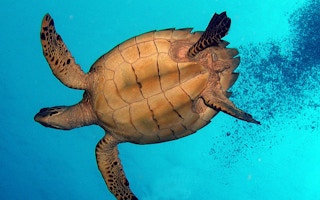The expanse of sand stretches hundreds of meters in both directions, featureless and flat, its dusty monotony alleviated only by the excavators, trucks and dredgers that dump sand and rocks into the sea and smooth out the newly-created land.
Billboards surrounding one site tout an aspirational dream of stylish apartments, luxury hotels and designer shopping malls. On the other side of the deserted highway that divides this artificial island, construction is already underway on an estate of extravagantly porticoed homes.
“We’re standing in the middle of the sea,” remarks one of the guards at the security post.
Over the past 20 years, reclamation has gobbled up swaths of ocean along Malaysia’s western coast, creating a man-made landscape of homes, offices, deep sea ports and cruise ship terminals. The state of Melaka, with its historic city overlooking the Strait of Malacca, began reclamation in 1974, but the process has gathered pace over the past two decades and a slew of recent projects have deepened concern about the environmental cost.
The island of Pulau Upeh is only a few kilometres north of the UNESCO-listed city. For generations it has been the state’s major nesting site for the critically-endangered hawksbill turtle (Eretmochelys imbricata), but reclamation is encroaching. Once two kilometres out to sea, Pulau Upeh is now only 600 metres offshore.
The effect on the turtle has been immense. From 111 landings in 2011, there were just 13 recorded as of October this year.
WWF Malaysia has been monitoring hawksbill activities on the island for a decade, and is concerned not only about the population in Pulau Upeh, but all along the coast of Melaka where there are at least ten nesting beaches. After Sabah in Malaysian Borneo, Melaka has the most significant population of hawksbills in the country.
“
It is a concern when we have technology that is enabling us to do mega projects cheaply.
Fairul Izmal Jamal Hisne, marine scientist and co-founder, MareCet
“We are advocating for a hydraulic study to see the effect of all these reclamation projects,” Lau Min Min, Team Leader of WWF’s Melaka hawksbill turtle conservation project told Mongabay during a visit to the turtle hatchery at Padang Kemunting, about 35 kilometres north of the city. “We need to do a stock check to see how these projects are affecting the beach and the sea.”
Advances in engineering, coupled with rising prices for land and a desire to avoid messy ownership disputes, are helping fuel a boom in reclamation across the region.
“Technology has advanced so much that what used to be a multibillion-dollar project is down to a multimillion-dollar investment,” said Fairul Izmal Jamal Hisne, a marine scientist and environmental consultant who co-founded Malaysian NGO MareCet five years ago to champion the conservation of marine mammals. “It is a concern when we have technology that is enabling us to do mega projects cheaply.”
China has a long history of coastal reclamation, and is now involved in some of the biggest projects in Malaysia, which wants to tap Chinese expertise in infrastructure engineering. Indonesia has triggered controversy with schemes in both Bali and Jakarta, while Singapore has built much of its prosperity on reclaimed land.
Chou Loke Ming, an adjunct research professor at the National University of Singapore’s Tropical Marine Science Institute says reclamation can have a widespread impact on the environment, from where the sand is dredged to where it’s dumped.
“Where the sand is deposited, burial of original biodiversity and habitats occur, suspended sediment increase will occur if not effectively managed, and changes in hydrodynamic patterns will affect biodiversity,” said Chou, who’s spent 30 years in marine science. “Because of water currents, these impacts are not confined to the specific dredge or dump site but to a wider area, so impacts on neighboring habitats are possible and the containing the spread of these impacts is crucial.”
Under Malaysian law, an Environmental Impact Assessment is mandatory for 19 types of activity, including land reclamation involving more than 50 hectares. Projects must also secure approval from the authorities at district and state level.
In Melaka, a three volume Macro Environmental Impact Assessment (EIA) covering coastal land reclamation in the state was finished in 1998. The report, which is not available online and has been removed from the Department of Environment’s central library along with other reports completed prior to 2004, covered 19 proposed projects and 2,835 hectares of land.
Idris Haron, the Chief Minister of Melaka, was travelling overseas and unavailable to talk to Mongabay about the state’s approach to reclamation.
Given the scale of the new plans and the potential impact on coastal communities and vulnerable marine life, the WWF and affected communities have been calling for more detailed EIAs. Turtle landings across the state as a whole have fallen from 481 in 2013 to 367 at the end of October this year.
The Melaka Green City Action Plan 2014, the city’s own sustainable development plan, noted the need for “a more thorough understanding of the increasing risks along the coastline.” It also noted that land reclamation projects had not “adequately addressed” the potential environmental damage from the “manipulation of the shoreline.”
This story was published with permission from Mongabay.com. Read the full story.










